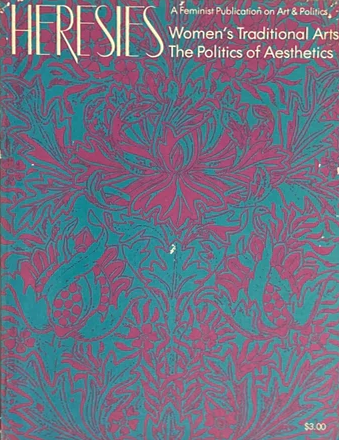
Women's Traditional Arts: The Politics of Aesthetics
Heresies Vol. 1, No. 4, Winter 1977-78
The Issue 4 Collective:
Ida Applebroog, Patsy Beckert, Joan Braderman, Mary Beth Edelson, Su Friedrich, Janet Froelich, Harmony Hammond, Sue Heinemann, Elizabeth Hess, Joyce Kozloff, Arlene Ladden, Lucy Lippard, Marty Pottenger, Miriam Schapiro, Amy Sillman, Joan Snyder, Elke Solomon, Pat Steir, May Stevens, Elizabeth Weatherford, Sally Webster.
| Editorial Group: | Martha Edelheit, Valerie Jaudon, Joyce Kozloff, Melissa Meyer, Carrie Rickey, Elizabeth Sacre, Miriam Schapiro, Elizabeth Weatherford, Sally Webster. |
| Design Group: | Francesca de Majo, Jean Feinberg, Paula Greif, Melissa Meyer and Janet Froelich, Julie Gross, Ama Kalina, Barbara Knight, Joyce Kozloff, Barbara Kruger, Mariam Schapiro. |
| Photography Group: | Deborah Jones-Dominguez, Judy Henry, Kunié, Dee Shapiro. |
| Production Group: | Cynthia Eardley, Su Friefrich, Margo Herr, Gail Lineback, Margot Norton, Carrie Rickey, Gail Schneider, Elizabeth Weatherford. |
Contributions:
Mexican Folk Pottery, Flora Kaplan
Editorial Statement, Fourth Issue Collective
The Aesthetics of Oppression, Judith Friedlander
Is There a Feminine Aesthetic? Silvia Bovenschen
Quilt Poem, Elizabeth Riley
Women Talking, Women Thinking, Joanna Russ
The Martyr Arts, Arlene Ladden
The Straits of Literature and History, Carrie Rickey
Afro-Carolinian "Gullah" Baskets, Howardena Pindell
The Left Hand of History, Teresa De Lauretis
Weaving, Madeleine Burnside
Political Fabrications: Women's Textiles in Five Cultures, Jean Feinberg, Lenore Goldberg, Julie Gross, Bella Lieberman, Elizabeth Sacre
Art Hysterical Notions of Progress and Culture, Valerie Jaudon and Joyce Kozloff
Excerpts from Women and the Decorative Arts, Linda Nochlin
The Woman's Building, Terre Grabenhorst-Randall
Ten Ways to Look at a Flower, Barbara Novak
Trapped Women: Two Sister Designers, Margaret and Frances MacDonald, Josephine Gear
Adelaide Alsop Robineau: Ceramist from Syracuse, Peg Weiss
Women of the Bauhaus, Martha Keller
Portrait of Frida Kahlo as a Tehuana, Hayden Herrera
Feminism: Has It Changed Art History? Mary D. Garrard
Are You a Closet Collector? Muriel Castanis
Making Something From Nothing, Lucy R. Lippard
Waste Not/Want Not: Femmage, Melissa Meyer and Miriam Schapiro
Sewing With My Great-Aunt Leonie Amestoy, Suzanne Noguere
The Apron: Status Symbol or Stitchery Sample?,Elli Siskind
Conversations and Reminiscences, Compiled by Martha Edelheit
Grandma Sara Bakes, Dee Shapiro
Aran Kitchens, Aran Sweaters, Patricia Patterson
Nepal Hill Art and Women's Traditions, Barbara Nimri Aziz
The Equivocal Role of Women Artists in Non-Literate Cultures, Jehanne H. Teilhet
Women's Art in Village India, Sharon Wood, Zette Emmons, Erika Moser
Pages from an Asian Notebook, Evelyn Stern
Quill Art, Carolyn Berry
Turkmen Women, Weaving and Cultural Change, Mary A. Martin
Kongo Pottery, Janet MacGaffey
Myth and the Sexual Division of Labor, Virginia Maksymowicz
Recitation of the Yoruba Bride
"By the Lakeside There Is an Echo": Towards a History of Women's Traditional Arts, Valerie Hollister and Elizabeth Weatherford
Bibliography
The fourth issue of Heresies, "Women's Traditional Arts: The Politics of Aesthetics" (1978) represents the challenges that the Collective was beginning to face - that producing a journal wasn't always aligned with their principles, and the recognition that there are tensions between collaboration and publication: "How could we collectively make a magazine that represented us all? How comfortable were we with each other's voices, with each other's images, with each other's ideas?" (From the Editorial Group)
The process of editing the issue, as described by the Group, aligns with the process of considering how the Bucknell Heresies Project should undertake the digitization and presentation of the materials within the issue. We struggled with how to annotate the texts deeply, revealing the women who not only produced the issue but those who were invoked in those pages. But at the same time, we have tried to find ways to manage the multimodality of the original pieces in ways that showed respect for the original editorial decisions that were made with regard to the interleaving and interpolation of text and image, and how we could reintroduce this in hypermedial ways that continue to elude us.
The textual components are currently viewable in collection that comprises the print-forward essays like Silvia Bovenshen's "Is There a Feminine Aesthetic?" and Joanna Russ's "Women Talking, Women Thinking", to more ethnographic interviews and discussions, such as the collected "Conversations & Reminiscences", to biographical sketches of artists and movements, like Josephine Gear's "Trapped Women: Two Sister Designers Margaret and Frances MacDonald" and Martha Kelle's "Women of the Bauhaus".
This featured collection is very much a work in progress: we have begun by capturing all named people and organizations within the texts and preparing them for publication as linked data to connect the Bucknell Heresies Project with other digital humanities research that centers intersectional feminism. We are currently undertaking annotation and glossing to offer our own research context for the issue. As elements come online we will present them as new experiments, all the while refining and respecting our source texts.
